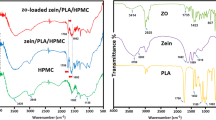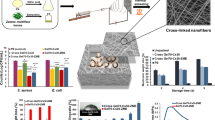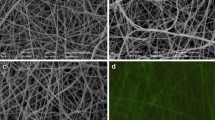Abstract
We explored electrospinning as a feasible and practicable mode for encapsulation and stabilization of Lactobacillus gasseri. The utilized nanocomposite was prepared using sol-gel composed of animate L. gasseri and inanimate PVA. The objective was to examine the ability of electrospinning method to protect functional properties of probiotic L. gasseri. The PVA was used as an encapsulation matrix as it is biocompatible and hydrophilic in nature thus facilitate an easy revival of bacteria. The characterization of as-spun bioproduct was done by energy-dispersive X-ray spectrometer, SEM, and TEM, whereas thermal behavior was analyzed by thermogravimetry. The viability was confirmed by traditional pour plate method and fluorescence microscopy. Furthermore, to test whether the functionality of L. gasseri was affected, the encapsulated L. gasseri were fed to mouse for colonization. Our results pointed out that encapsulated bacteria were viable for months, and their metabolism was not affected by immobilization; thus, they could be used in food engineering and trade.






Similar content being viewed by others
References
Alisky J, Iczkowski K, Rapoport A, Troitsky N (1998) Bacteriophages show promise as antimicrobial agents. J Infection 36:5–15
Barrow PA, Soothill JS (1997) Bacteriophage therapy and prophylaxis: rediscovery and renewed assessment of potential. Trends Microbiol 5:268–271
Capela P, Hay TKC, Shah NP (2006) Effect of cryoprotectants, prebiotics and microencapsulation on survival of probiotic organisms in yoghurt and freeze-dried yoghurt. Food Res Int 39(2):203–211
Commane D, Hughes R, Shortt C, Rowland I (2005) The potential mechanisms involved in the anti-carcinogenic action of probiotics. Mutat Res 591(1–2):276–289
De Champs C, Maroncle N, Balestrino D, Rich C, Forestier C (2003) Persistence of colonization of intestinal mucosa by a probiotic strain, Lactobacillus casei subsp. rhamnosus Lcr35, after oral consumption. J Clin Microbiol 41(3):1270–1273
Dror Y, Salalha W, Khalfin RL, Cohen Y, Yarin AL, Zussman E (2003) Carbon nanotubes embedded in oriented polymer nanofibers by electrospinning. Langmuir 19(7):7012–7020
Fung WY, Yuen KH, Liong MT (2011) Agrowaste-based nanofibers as a probiotic encapsulant: fabrication and characterization. J Agric Food Chem 59:8140–8147
Greene JD, Klaenhammer TR (1994) Factors involved in adherence of lactobacilli to human Caco-2 cells. Appl Environ Microbiol 60:4487–4494
Greiner A, Wendorff JH (2007) Electrospinning: a fascinating method for the preparation of ultrathin fibers. Angew Chem Int Ed 46:5670
Heunis TDJ, Botes M, Dicks LMT (2010) Encapsulation of Lactobacillus plantarum 423 and its bacteriocin in nanofibers probiotics and antimicrobial proteins. Probiotics Antimicrob Proteins 2(1):46–51
Itoh T, Fujimoto Y, Kawai Y, Toba T, Saito T (1995) Inhibition of food-borne pathogenic bacteria by bacteriocins from Lactobacillus gasseri. Lett Appl Microbiol 21:137–141
Kim CK, Kim BS, Sheikh FA, Lee US, Khil MS, Kim HY (2007) Amphiphilic poly(vinyl alcohol) hybrids and electrospun nanofibers incorporating polyhedral oligosilsesquioxane. Macromolecules 40:4823–4828
Kitazawa H, Tomioka Y, Matsumura K, Aso H, Mizugaki M, Itoh T, Yamaguchi T (1994) Expression of mRNA encoding IFN alpha in macrophages stimulated with Lactobacillus gasseri. FEMS Microbiol Lett 120:315–321
Kullen MJ, Sanozky Dawes RB, Crowell DC, Klaenhammer TR (2000) Use of DNA sequence of variable regions of the 16SrRNA gene for rapid and accurate identification of bacteria in the Lactobacillus acidophilus complex. J Appl Microbiol 89:511–518
Kurtmann L, Carlsen CU, Risbo J, Skibsted LH (2009) Storage stability of freeze dried Lactobacillus acidophilus (La-5) in relation to water activity and presence of oxygen and ascorbate. Cryobiology 58(2):175–180
Lee S-W, Belcher AM (2004) Virus-based fabrication of micro- and nanofibers using electrospinning. Nano Lett 4:387–390
Li JX, He AH, Charles CH, Fang DF, Hsiao BS, Chu B (2006) Electrospinning of hyaluronic acid (HA) and HA/gelatin blends. Macromol Rapid Commun 27:114–120
Liu F, Huang L (2002) Development of non-viral vectors for systemic gene delivery. J Controll Release 78:259–266
Liu Y, Rafailovich MH, Malal R, Cohn D, Chidambaram D (2009) Engineering of bio-hybrid materials by electrospinning polymer-microbe fibers. Proc Natl Acad Sci. doi:10.1073/pnas0903238106
Lopez-Rubio A, Sanchez E, Sanz Y, Lagaron JM (2009) Encapsulation of living bifidobacteria in ultrathin PVOH electrospun fibers. Biomacromolecules 10:2823–2829
Lye H-S, Kuan CY, Ewe J-A, Fung W-Y, Liong M-T (2009) The improvement of hypertension by probiotics: effects on cholesterol, diabetes, renin, and phytoestrogens. Int J Mol Sci 10:3755–3775
Meiners J-A (2009) Micro-encapsulation of probiotics. In Prebiotics and Probiotics Science and Technology; Charalampopoulos, D, Rastall RA, Eds.; Springer Science + Business Media: Heidelberg, NY
Mitsuoka T (1992) The human gastrointestinal tract. In: Wood BJB (ed) The lactic acid bacteria: volume 1, the lactic acid bacteria in health and disease. Elsevier Science Publishers, Ltd, Essex, pp 69–114
Moore WEC, Holdeman LV (1975) Discussion of current bacteriologic investigations of the relationships between intestinal flora, diet and colon cancer. Cancer Res 35:3418–3420
Morais D, Stillings MG, Dersch C, Rudisile R, Pranke MP, Vieira Costa JA, Wendorff J (2010) Preparation of nanofibers containing the microalga Spirulina (Arthrospira). Bioresource Technol 101:2872–2876
Muralimohan A, Eun Y-J, Bhattacharyya B, Weibel DB (2009) Dissecting microbiological systems using materials science. Trends Microbiol 17:100–108
Pedrosa MC, Golner BB, Goldin BR, Barakat S, Dallal GE, Russell RM (1995) Survival of yogurt-containing organisms and Lactobacillus gasseriA (ADH) and their effect on bacterial enzyme activity in the gastrointestinal tract of healthy and hypocholorhydric elderly subjects. Am J Clin Nutr 61:353–359
Peresin MS, Habibi Y, Zoppe JO, Pawlak JJ, Rojas OJ (2010) Nanofiber composites of poly(vinyl alcohol) and cellulose nanocrystals: manufacture and characterization. Biomacromolecules 11(3):674–681
Salalha W, Kuhn J, Dror Y, Zussman E (2006) Encapsulation of bacteria and viruses in electrospun nanofibres. Nanotechnology 17(18):4675–4681
Shao C, Kim HY, Gong J, Ding B, Lee DR, Park SJ (2003) Fiber mats of poly(vinyl alcohol)/silica composite via electrospinning. Mater Lett 57:1579–1584
Wu H, Fan J, Qin X, Zhang G (2008) Thermal radiative properties of electrospun superfine fibrous PVA films. Mater Lett 62(6–7):828–831
Zheng H, Du YM, Yu JH, Huang RH, Zhang LN (2001) Preparation and characterization of chitosan/poly(vinyl alcohol) blend fibers. J Appl Polym Sci 80:2558–2565
Acknowledgments
This work was supported by research funds of Chonbuk National University in 2012. This work has been partly supported by a grant from Next Generation BioGreen 21 Program (no. PJ008191), Rural Development Administration, Republic of Korea. Dr. Touseef Amna sincerely acknowledges the financial support from Research Academic Promotion Programme 2012 of Chonbuk National University.
Author information
Authors and Affiliations
Corresponding authors
Rights and permissions
About this article
Cite this article
Amna, T., Hassan, M.S., Pandeya, D.R. et al. Classy non-wovens based on animate L. gasseri-inanimate poly(vinyl alcohol): upstream application in food engineering. Appl Microbiol Biotechnol 97, 4523–4531 (2013). https://doi.org/10.1007/s00253-012-4666-z
Received:
Revised:
Accepted:
Published:
Issue Date:
DOI: https://doi.org/10.1007/s00253-012-4666-z




